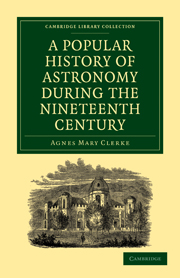Book contents
- Frontmatter
- PREFACE
- Contents
- INTRODUCTION
- Part I PROGRESS OF ASTRONOMY DURING THE FIRST HALF OF THE NINETEENTH CENTURY
- Part II RECENT PROGRESS OF ASTRONOMY
- CHAPTER I FOUNDATION OF ASTRONOMICAL PHYSICS
- CHAPTER II SOLAR OBSERVATIONS AND THEORIES
- CHAPTER III RECENT SOLAR ECLIPSES
- CHAPTER IV SPECTROSCOPIC WORK ON THE SUN
- CHAPTER V TEMPERATURE OF THE SUN
- CHAPTER VI THE SUN'S DISTANCE
- CHAPTER VII PLANETS AND SATELLITES
- CHAPTER VIII PLANETS AND SATELLITES (continued)
- CHAPTER IX THEORIES OF PLANETARY EVOLUTION
- CHAPTER X RECENT COMETS
- CHAPTER XI RECENT COMETS (continued)
- CHAPTER XII STARS AND NEBULÆ
- CHAPTER XIII METHODS OF RESEARCH
- INDEX
CHAPTER XI - RECENT COMETS (continued)
Published online by Cambridge University Press: 07 September 2011
- Frontmatter
- PREFACE
- Contents
- INTRODUCTION
- Part I PROGRESS OF ASTRONOMY DURING THE FIRST HALF OF THE NINETEENTH CENTURY
- Part II RECENT PROGRESS OF ASTRONOMY
- CHAPTER I FOUNDATION OF ASTRONOMICAL PHYSICS
- CHAPTER II SOLAR OBSERVATIONS AND THEORIES
- CHAPTER III RECENT SOLAR ECLIPSES
- CHAPTER IV SPECTROSCOPIC WORK ON THE SUN
- CHAPTER V TEMPERATURE OF THE SUN
- CHAPTER VI THE SUN'S DISTANCE
- CHAPTER VII PLANETS AND SATELLITES
- CHAPTER VIII PLANETS AND SATELLITES (continued)
- CHAPTER IX THEORIES OF PLANETARY EVOLUTION
- CHAPTER X RECENT COMETS
- CHAPTER XI RECENT COMETS (continued)
- CHAPTER XII STARS AND NEBULÆ
- CHAPTER XIII METHODS OF RESEARCH
- INDEX
Summary
The mystery of comets' tails has been to some extent penetrated; so far, at least, that, by making certain assumptions strongly recommended by the facts of the case, their forms can be, with very approximate precision, calculated beforehand. We have, then, the assurance that these extraordinary appendages are composed of no ethereal or super-sensual stuff, but of matter such as we know it, and subject to the ordinary laws of motion, though in a state of extreme tenuity. This is unquestionably one of the most remarkable discoveries of our time.
Olbers, as already stated, originated in 1812 the view that the tails of comets are made up of particles subject to a force of electrical repulsion proceeding from the sun. It was developed and enforced by Bessel's discussion of the appearances presented by Halley's comet in 1835. He, moreover, provided a formula for computing the movement of a particle under the influence of a repulsive force of any given intensity, and thus laid firmly the foundation of a mathematical theory of cometary emanations. Professor W. A. Norton of Yale College considerably improved this by inquiries begun in 1844, and resumed on the apparition of Donati's comet; and Dr. C. F. Pape at Altonax gave numerical values for the impulses outward from the sun, which must have actuated the materials respectively of the curved and straight tails adorning the same beautiful and surprising object.
- Type
- Chapter
- Information
- A Popular History of Astronomy During the Nineteenth Century , pp. 384 - 410Publisher: Cambridge University PressPrint publication year: 2010First published in: 1885



